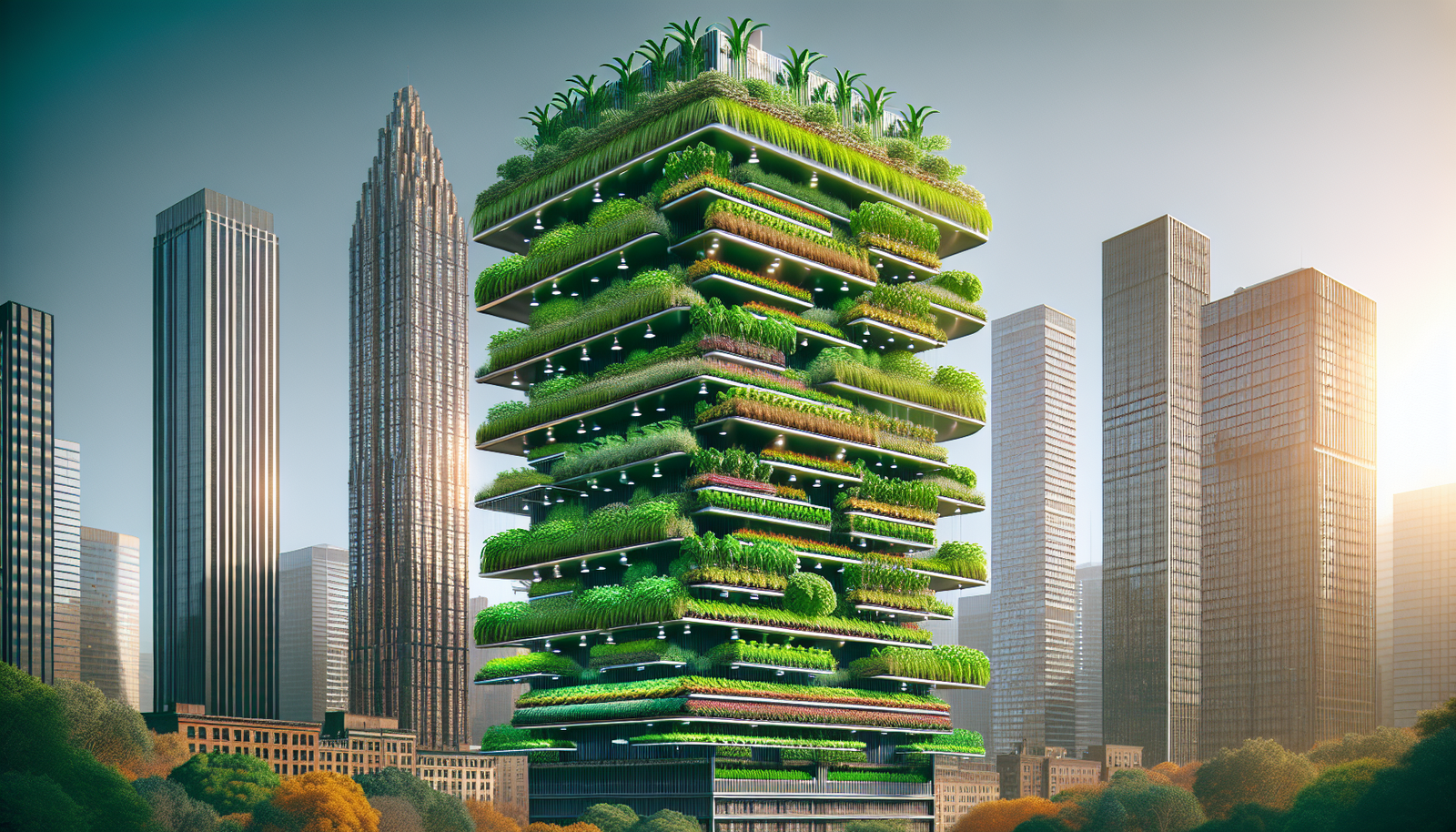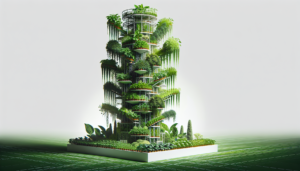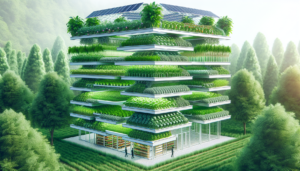
Imagine a world where lush green fields and bountiful crops are not limited to the rural countryside, but can be found towering above the city skyline. This vision is becoming a reality in Massachusetts, where vertical farming is revolutionizing the agriculture industry. By utilizing advanced technology and innovative techniques, farmers are now able to grow crops in vertically-stacked layers, significantly increasing yield and minimizing the need for traditional farmland. In this article, we will explore the promising future of vertical farming in Massachusetts and the potential it holds for sustainable food production in urban areas.
Benefits of Vertical Farming
Increased crop yield
Vertical farming allows for the cultivation of crops in stacked layers, maximizing the use of available space. By using techniques such as hydroponics and aeroponics, plants can be grown without soil and receive a constant supply of nutrients. This controlled environment optimizes growth conditions, resulting in higher yields compared to traditional farming methods.
Conservation of land and water resources
The vertical farming system takes advantage of vertical space rather than sprawling across vast areas of land. This means that less land is required for agricultural purposes, which can help protect natural habitats and minimize deforestation. Additionally, vertical farming utilizes significantly less water compared to conventional farming by recycling and reusing water within the closed-loop system, leading to sustainable water management.
Reduced transportation costs
With vertical farming, crops can be grown closer to urban centers and consumer markets, eliminating the need for long-distance transportation. This not only reduces transportation costs but also decreases the carbon emissions associated with moving produce from rural areas to urban populations. Locally grown vertical farm produce can be harvested and delivered to consumers at peak freshness, enhancing taste and nutritional value.
Year-round production
Vertical farms are not limited by seasonal changes or adverse weather conditions. By controlling the environment through technologies such as climate control systems and LED lighting, crops can be grown year-round. This ensures a consistent supply of fresh produce even during off-seasons, reducing the dependence on imported fruits and vegetables for local consumers.
Less reliance on pesticides
In a controlled environment, pests and diseases can be better managed, reducing the need for pesticides while maintaining crop health. Vertical farming systems often incorporate natural pest control methods, such as introducing beneficial insects or using biological agents to target specific pests. This results in the production of pesticide-free and healthier food, benefiting both the consumers and the environment.
Enhanced food safety and quality
Vertical farming allows for complete control over the growing conditions, minimizing the risk of contamination and ensuring food safety. By eliminating exposure to external contaminants, such as pollutants or wildlife, the quality of produce can be enhanced. Additionally, the shorter supply chain and reduced time from harvest to consumption in vertical farming can preserve the nutritional value and flavor of the crops.
Challenges of Vertical Farming
High initial investment
One of the major challenges of vertical farming is the high upfront investment required to set up the necessary infrastructure and technologies. Vertical farms need specialized equipment such as LED lights, climate control systems, and automated systems, which can be costly. However, as technology advances and economies of scale come into play, the cost of vertical farming equipment is expected to decrease, making it a more accessible option in the future.
Energy consumption
The technological requirements of vertical farming, such as artificial lighting and climate control systems, result in higher energy consumption compared to traditional farming methods. However, advancements in energy-efficient technologies, such as LED lights, can help mitigate this challenge. Additionally, vertical farming systems can potentially integrate renewable energy sources to reduce the reliance on non-renewable energy.
Limited crop variety
Vertical farming is currently best suited for growing leafy greens, herbs, and certain vine crops. The technology and infrastructure required for cultivating certain crops, such as large fruiting plants or root vegetables, are still being developed. As research and innovation in vertical farming progress, it is expected that a wider range of crops will be successfully grown in vertical farms.
Market demand and consumer acceptance
Vertical farming is a relatively new concept that may face challenges in gaining widespread consumer acceptance and demand. Educating consumers about the benefits, sustainability, and quality of vertical farm produce will be crucial in building market demand. Collaborative efforts between vertical farmers, retailers, and consumers can help create awareness and promote the value of locally grown, sustainable food.
Technological limitations
As with any emerging industry, vertical farming faces technological limitations that need to be overcome for optimal efficiency and productivity. This includes improving automation and robotics in the farming processes, ensuring precise control of environmental parameters, and developing sensors and monitoring systems for real-time data analysis. Continuous investments in research and development will drive technological advancements in vertical farming.
Vertical Farming in Massachusetts
Current state of agriculture in Massachusetts
Massachusetts, known for its diverse agricultural landscape, has a rich history of farming. However, traditional agricultural practices face challenges due to limited arable land and changing climatic conditions. The state’s agricultural sector focuses primarily on dairy farming, cranberry bogs, and apple orchards, with a smaller presence of vegetable farms. To overcome these challenges and ensure food security, vertical farming presents a viable solution in Massachusetts.
Advantages of vertical farming in Massachusetts
The vertical farming system aligns well with Massachusetts’ urban landscape and densely populated areas. By utilizing vertical space within buildings or repurposed structures, such as warehouses or shipping containers, vertical farms can maximize land efficiency. This is particularly significant in a state where available land for agriculture is limited.
Massachusetts’ changing climate patterns, including extreme temperatures and unpredictable weather events, pose risks to traditional agriculture. Vertical farming’s controlled environment mitigates these risks, ensuring consistent production despite external climatic conditions. The ability to grow food year-round is especially valuable in Massachusetts, where harsh winters limit traditional farming practices.
Government support and initiatives
Recognizing the potential benefits of vertical farming, the Massachusetts government has taken steps to support and encourage its development. The Massachusetts Department of Agricultural Resources provides grants, loans, and technical assistance to farmers and agricultural businesses, including those engaged in vertical farming. These initiatives aim to improve access to funding and resources, enabling vertical farming startups to succeed.
Successful vertical farming projects in Massachusetts
Massachusetts is home to several successful vertical farming projects that have gained recognition for their innovative approaches. Green City Growers” is a Boston-based urban farming company that specializes in rooftop gardens and vertical farming installations. They collaborate with schools, businesses, and communities to promote sustainable agriculture and food education.
Another notable project is “Grove Labs,” a vertical farming startup that develops indoor gardening systems for homes and commercial applications. Their systems use advanced technology to enable individuals and businesses to grow their own fresh produce effortlessly. These successful local projects illustrate the viability and potential of vertical farming in Massachusetts.
Technology in Vertical Farming
Automated systems and robotics
Automation plays a pivotal role in vertical farming, optimizing efficiency and productivity. Automated systems can handle tasks such as seeding, transplanting, irrigation, and harvesting, reducing labor requirements. Robotics further enhance these processes, with robots capable of precise planting, plant health monitoring, and crop maintenance. Continued advancements in automation and robotics will revolutionize the vertical farming industry, making it more accessible and economically viable.
Artificial intelligence and machine learning
Artificial intelligence (AI) and machine learning (ML) have the potential to transform vertical farming by analyzing data and optimizing crop growth conditions. AI algorithms can process environmental data, plant health indicators, and historical records to make data-driven decisions, such as adjusting lighting, temperature, and nutrient levels. This technology empowers vertical farmers to maximize plant health, growth, and productivity while minimizing resource usage.
Hydroponics and aeroponics
Hydroponic and aeroponic systems are widely used in vertical farming due to their water efficiency and ability to deliver nutrients directly to plant roots. Hydroponics involves growing plants in a nutrient-rich water solution, eliminating the need for soil. Aeroponics, on the other hand, suspends plant roots in a misted environment, providing optimal oxygenation and nutrient absorption. Both techniques save water, reduce the risk of diseases, and promote faster plant growth.
LED lighting
LED lighting is a cornerstone technology in vertical farming, providing the necessary light spectrum for plant growth. LED lights can be customized to emit specific wavelengths that optimize photosynthesis and control plant morphology. Compared to traditional lighting systems, such as fluorescent or incandescent lights, LEDs are more energy-efficient and generate less heat. Their longevity and low maintenance requirements make them a cost-effective lighting solution for vertical farms.
Climate control systems
Vertical farms rely on climate control systems to create and maintain the ideal growing conditions for crops. These systems regulate temperature, humidity, CO2 levels, and air circulation, mimicking the optimal conditions for plant growth. Precise control of these environmental factors ensures consistent crop yields and minimizes the risk of diseases or pest infestations. Advances in climate control technologies allow vertical farmers to adapt to various crop requirements while conserving energy.
Environmental Impact
Reduced carbon footprint
Vertical farming reduces the carbon footprint associated with traditional agriculture methods. By growing produce closer to urban centers, transportation distances are significantly reduced, leading to lower carbon emissions. Furthermore, the controlled environment in vertical farms enables energy-efficient operations and the integration of renewable energy sources, lowering overall greenhouse gas emissions.
Water conservation
Water scarcity and the efficient use of water resources are critical global challenges. Vertical farming addresses these concerns by utilizing recirculating water systems and advanced irrigation methods. Through techniques like hydroponics and aeroponics, water usage can be minimized as plants directly receive the required amount of water without excessive loss through soil absorption. Additionally, vertical farms can capture and reuse water, further conserving this essential resource.
Efficient use of resources
Vertical farming optimizes resource usage by maximizing land, water, and energy efficiency. The vertical structure allows for higher crop density, producing more food per square foot compared to traditional farming. With precise control over nutrient delivery and environmental parameters, vertical farms use fertilizer and other inputs more efficiently, reducing waste and environmental impact. This sustainable approach contributes to the conservation of natural resources and helps secure a more resilient food supply.
Economic Impact
Job creation
The implementation of vertical farming in Massachusetts can create new employment opportunities. Vertical farms require skilled professionals in areas such as horticulture, plant biology, systems engineering, and data analysis. Additionally, these facilities may generate jobs in marketing, distribution, and maintenance. By fostering the growth of the vertical farming industry, Massachusetts can stimulate job creation and support the development of a skilled workforce.
Boost to local economy
Vertical farming offers the potential for a localized and resilient food system. By reducing the dependence on imported produce, vertical farming keeps the economic benefits within the local community. The growth of vertical farming in Massachusetts can stimulate economic activity by supporting local farmers, promoting small businesses, and fostering collaborations between vertical farms and local restaurants, grocery stores, and farmers’ markets.
Reduced dependence on imports
Massachusetts currently relies on imports to meet a significant portion of its fresh produce needs, especially during the winter months. Vertical farming’s year-round production capabilities can reduce this dependence on imports. By producing a diverse range of fresh and locally grown crops, vertical farms can enhance food security, decrease reliance on external sources, and minimize the risks associated with disruptions in the global food supply chain.
Future Developments and Trends
Integration of vertical farming with urban architecture
In the future, the integration of vertical farming with urban architecture will play a crucial role in sustainable urban development. Vertical farms can be incorporated into new buildings or integrated into existing structures, helping create self-sufficient communities with easy access to fresh produce. Rooftop gardens, green walls, and vertical farm installations will become increasingly common features in urban landscapes, transforming cities into more livable and resilient environments.
Advancements in sustainable farming techniques
Research and development efforts are continuously improving sustainable farming techniques in vertical farms. This includes advancements in nutrient management, natural pest control methods, and soil-less cultivation systems. Sustainable practices such as organic hydroponics, vertical stacking systems, and closed-loop nutrient cycles will become more prevalent, ensuring that vertical farming remains an environmentally friendly and resource-efficient method of food production.
Focus on biosecurity and disease prevention
Vertical farming’s controlled environment offers better biosecurity measures and disease prevention compared to traditional agriculture. As the industry matures, there will be increased focus on mitigating risks associated with pests, diseases, and contaminations. Adoption of strict hygiene protocols, regular monitoring, and use of smart sensors will help ensure food safety and prevent potential outbreaks. Vertical farming’s closed-loop systems minimize the risk of cross-contamination between crops, further enhancing food security.
Development of vertical farming startups
Vertical farming startups will continue to play a vital role in driving innovation and expanding the industry. These startups, backed by investment and technological advancements, will focus on improving operational efficiency, reducing costs, and increasing crop variety. Collaboration among startups, research institutions, and established agricultural organizations will strengthen the knowledge base and accelerate the adoption of vertical farming practices.
Conclusion
Vertical farming offers numerous benefits, ranging from increased crop yield and conservation of resources to improved food safety and quality. Although it faces challenges such as high initial investment and limited crop variety, technological advancements and supportive government initiatives can pave the way for successful vertical farming in Massachusetts. With its urban landscape, changing climate, and economic potential, Massachusetts is well-suited to embrace and benefit from vertical farming. By leveraging technology, prioritizing sustainability, and nurturing a thriving industry, Massachusetts can secure a more resilient and sustainable future for its agriculture and food system.







